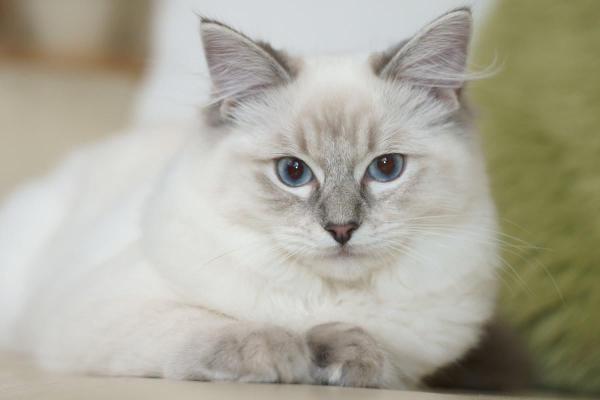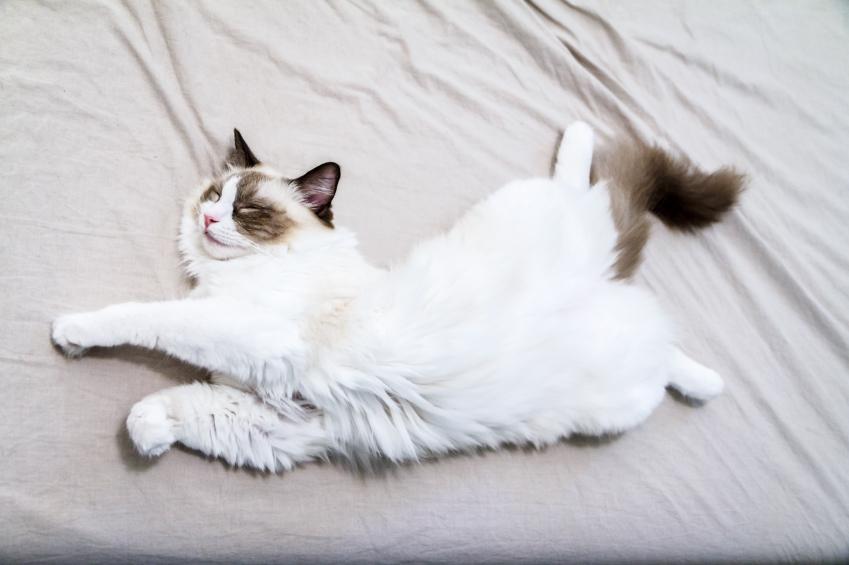Health Problems of Ragdoll Cats



See files for Cats
Ragdoll cats are one of the largest breeds of domestic cat (they still don't quite rival the heft of a tiger) with males being larger than females. They originated in the United States of America from different breeds such as the Persian, Siamese and Birmese. In recent decades, these felines have become very popular as pets largely due to their remarkable physical beauty and temperate behavior. Ragdolls are loyal and affectionate cats which establish closer bonds with their guardians, a necessity for their health and well-being.
In general, Ragdoll cats have very good health and a life span lasting between 10 and 15 years. However, they need adequate preventative medicine as well as essential care maintenance to maintain good health and behavior. This is why AnimalWised presents common health problems of Ragdoll cats so you can help make your own cat's life as happy and healthy as possible.
Inbreeding in Ragdoll cats
Inbreeding can be described as mating individuals which are closely related genetically. This means between siblings, parents and offspring or even later generations. Although less common in mammals, these occurrences can occur spontaneously in nature, such as between mountain gorillas, cheetahs or bees. However, it is something often induced by humans. This is especially so with cat and dog breeders who try to encourage certain genetic traits, usually of the physical kind. They do this to create a standardized breed which appeals to pet owners, but also comes with physical defects which can seriously impair their health.
In Ragdoll cats, inbreeding is a serious problem. About 45% of their genes come from a single Ragdoll cat, appropriately named Daddy Warbucks. Individuals bred from a inbred crosses have a low genetic variety, making them prone to hereditary and degenerative diseases. It also reduces their life expectancy.
Additionally, these individuals have reduced rates of success when it comes to birthing rates and often give birth to malformed kittens. They will generally produce smaller litters and their offspring have a weaker immune system, increasing their mortality rate and reducing chances of survival of both the individual cat and the breed as a whole.
Obesity in Ragdoll cats
Ragdoll cats are noted for their tameness, enjoying a relatively quiet lifestyle. In general, they are not as active as other breeds of cat, but this doesn't mean they don't need exercise and physical stimulation. They live relatively sedentary lives and are known for their keenness to be held and affection towards humans. They will often become so relaxed when held that their bodies turn limp, making them feel like a ragdoll. Such a sedentary lifestyle may be great for caregivers who have an equally relaxed approach to life. However, it also means they have a greater propensity towards obesity. This is why tutors need not only to provide a balanced nutritional diet, but also encourage exercise, play games and stimulate their mind and body with activities on a regular basis.
Environmental enrichment is key to providing an environment which triggers curiosity in your cat, helping them to become encouraged to play even when you are not around. An enriched home is one with lots of places to explore, has objects with which they can interact and is free from stressors. It should be able to stimulate the cognitive, emotional and social abilities of your cat, helping to prevent both stress and boredom.

Urinary tract infections in Ragdoll cats
Problems with the urinary tract stand out as being one of the most common diseases for Ragdoll cats. This can affect any part of the urinary tract which includes the ureters, urethra, bladder and even the kidneys. Among the most frequent urinary disorders we see in cats are the following:
- Urinary tract infection
- Cystitis
- Feline lower urinary tract disease (previously known as feline urological syndrome)
Each of the above disease has their own symptoms, the acuteness of which will depend on the overall state of health of the individual cat as well as the stage of the disease. However, there are some general signs which may indicate a urinary tract condition:
- Constant desire to urinate, but difficulty in doing so
- Intensive or consistent licking of the genitals
- Pain when urinating
- Straining to urinate
- Blood in urine
- Urinary incontinence (urinating outside of the litterbox, either nearby or otherwise unusual places)
Hairballs and digestive problems in Ragdoll cats
As with most longhair or semi-longhair cat breeds, Ragdolls can suffer digestive problems from the accumulation of hair. As they are very clean animals, cats groom themselves (and each other) constantly. In the process, they can ingest hair which leads to accumulation in the digestive system, often resulting in a hairball which must be expunged.
If the cat manages to naturally expunge the hairball, it should not offer any alteration to their health. However, if the cat is unable to purge the collected hair properly, you may see the following symptoms:
- General malaise
- Apathy
- Frequent gagging
- Regurgitation without expelling anything
- Vomiting of liquid and food
To help prevent the formation of hairballs in your Ragdoll cat, it is essential to brush them regularly to remove dead hair and dirt. To help maintain the beauty and health of a Ragdoll's fur, we have some advice on brushes to use for longhair cats as well as some tips on how to detangle knots.
Additionally, malt paste has been advised by some veterinarians to be used as a safe and effective way to help your kitten purge themselves of hairballs. Additionally, it may be able to help stimulate them sensorially and encourage their physical and cognitive abilities.

Polycystic kidney disease in Ragdoll cats
Polycystic kidney disease is a hereditary disease which is most commonly diagnosed in Persian and Exotic Shorthair cats, but is also prevalent in Ragdoll cats. The clinical picture is one where fluid filled cysts grow within the kidney either in utero, during childhood or even in adulthood. As the cat grows, these cysts increase in size and can lead to severe kidney damage as well as kidney failure.
Some of the symptoms of polycystic kidney disease include:
- Loss of apetite
- Weightloss
- Weakness
- General malaise
- Depression/lethargy
- High water intake
- Frequent urination
The castration or sterilization of cats with polycystic kidney disease is a crucial preventative measure to prevent the transmission of the disease. It is also helpful in controlling overpopulation and reducing the strain on the resources of animal shelters.
Hypertrophic cardiomyopathy in Ragdoll cats
Feline hypertrophic cardiomyopathy is the most common cardiac disease in domestic cats, but is a particular worry to some breeds such as the Ragdoll cat. It is characterized by the thickening of the myocardial mass of the left ventricle, leading to a reduction in the volume of the cardiac chamber in the heart.
As a result of this thickening, the feline's heart is unable to adequately pump blood to other tissues and organs of the body. Complications due to poor circulation are likely to appear, which can include thromboembolism (the formation of blood clots in different parts of the body which impair organic function).
Although hypertrophic cardiomyopathy can affect all cats, it is most common in older males. Its symptoms depend on the state of health of the cat and the progress of the disease. There are also some cases where the cat remains asymptomatic (i.e. not showing any overt symptoms). However, the most characteristic symptoms of hypertrophic cardiomyopathy in cats include:
- Apathy
- Dyspnea (shortness of breath)
- Vomiting
- Difficulty breathing
- Appetite loss
- Weightloss
- Depression and lethargy
- Flaccidity in the reare limbs
- Sudden death

Visit your veterinarian
Now you know the most common diseases in Ragdoll cats, you will understand the importance of regular checkups at the vet. This is of course, after initial treatment after adoption where they are provided with an appropriate vaccination and deworming schedule. Deworming will be required more regularly as the effects are not as long-lasting as innoculations, although booster shots may be required. After an initial health assessment, regular checkups every 6 to 12 months is advised.
You will also need to keep a close eye on any physical changes as well as those to their behavior or demeanor. You can do this when you pet them, play with them or even bathing them. If you see any changes which look like they may be symptoms of any of the above diseases or similar conditions, do not hesitate to bring your cat to the vet to rule out any issues or provide appropriate treatment.
This article is purely informative. AnimalWised does not have the authority to prescribe any veterinary treatment or create a diagnosis. We invite you to take your pet to the veterinarian if they are suffering from any condition or pain.
If you want to read similar articles to Health Problems of Ragdoll Cats, we recommend you visit our Hereditary diseases category.








